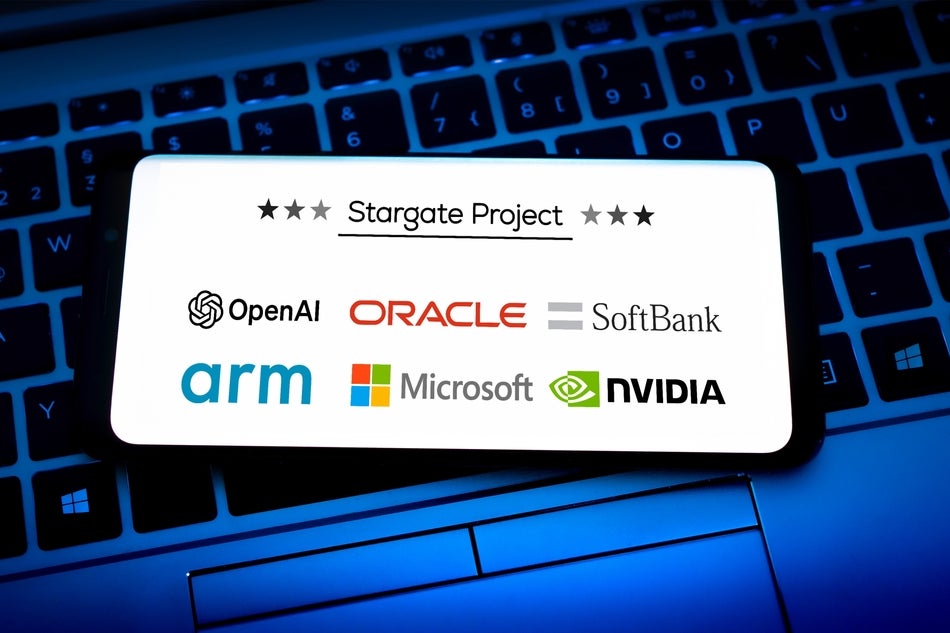Insights from Industry Experts on the $100 Billion Stargate Project Involving OpenAI, Oracle, and Nvidia

The OpenAI and Oracle Partnership: Transforming AI Infrastructure
The collaboration between OpenAI and Oracle Corp. is set to revolutionize AI infrastructure through their ambitious data center project named Stargate. Valued at an astonishing $100 billion, this initiative will kick off with a facility in Texas and has the potential to significantly influence the demand for semiconductors and enhance high-performance AI computing. Central to this project are Nvidia’s latest GB200 chips, highlighting the fierce competition in the AI supercomputing domain.
The Geopolitical Stakes of AI Development
Adam Patti, CEO of VistaShares, describes Stargate as a crucial moment in the current race for AI technology, emphasizing its geopolitical significance. “This announcement marks a seismic shift in the global AI arms race,” he said in a statement to Benzinga. He pointed out that shortly after the U.S. introduced Stargate, China revealed its DeepSeek initiative, further underlining the intense competition between nations and companies for leadership in AI innovation.
Investment Opportunities in AI Infrastructure
With the massive capital expenditure required for AI infrastructure, various exchange-traded funds (ETFs) focused on AI data centers and semiconductor supply chains are expected to thrive. Patti noted that while most AI investment strategies target consumer applications and well-established tech giants, ETFs concentrating on AI infrastructure can grab immediate profits from these capital investments.
- VistaShares Artificial Intelligence Supercycle ETF (AIS): Patti highlights this ETF as the only one providing pure exposure to AI infrastructure. He explains that the companies constructing this infrastructure are generating immediate profits with expected massive growth in the next few years.
- Nvidia’s Role: Sylvia Jablonski, CEO of Defiance ETFs, predicts that Nvidia will continue to dominate AI computing. This dominance will likely lead semiconductor ETFs (like SOXX and SMH) to increase their allocations to Nvidia.
Key ETFs to Watch
Nicholas Frasse, a product manager at VanEck, also supports the idea that semiconductor ETFs will benefit from developments in AI infrastructure. “Semiconductors are the backbone of AI technology,” he noted, indicating that the spending related to Stargate will boost various semiconductor sectors positively. Key ETFs identified include:
- VanEck Semiconductor ETF (SMH): Focuses on leading companies in semiconductor manufacturing and design.
- VanEck Fabless Semiconductor ETF (SMHX): Targets fabless companies crucial in the development of AI technologies.
Future Developments in ETF Offerings
While current ETFs offer broad exposure to AI, there may be new funds designed specifically for AI infrastructure investments. However, Patti advised potential investors to scrutinize the processes and expertise behind these new options. Frasse suggested the semiconductor sector remains the most direct way to benefit from AI advancements, emphasizing Nvidia’s strong market presence but acknowledging that competition is intensifying.
The Broader Implications of Stargate
Jablonski spoke about the broader impacts of Stargate, suggesting it will significantly contribute to both AI and the semiconductor industries. “The expansion of data centers means a greater need for GPUs and chips, benefiting companies like Nvidia, AMD, and Oracle,” she remarked. She believes this collaboration will enhance the speed and power of AI, integrating with quantum computing and cloud services as part of a larger industrial evolution.
Investment Risks to Consider
Despite the promising projections for AI infrastructure investments, investors should remain aware of potential regulatory and geopolitical risks. Patti pointed out that governments need to create reasonable regulations that protect interests while promoting growth. Trade barriers and competitive pressures between AI powerhouses like the U.S. and China may shape how investment flows occur in the future.
- Tariffs and Supply Chain Disruptions: Jablonski warned about the ongoing trade war and how different regulations on AI could impact investment.
- Financial Health Indicators: Frasse advised investors to monitor the financial stability and R&D spending of companies. Cash-rich firms like Nvidia can better navigate these investments.
Jablonski further emphasized that companies with lower debt levels could be positioned for greater growth compared to more heavily indebted firms. Investors should carefully consider their choices when allocating their funds to capitalize on the ongoing growth in the AI sector.
This initiative from OpenAI and Oracle represents a critical moment in the evolution of AI infrastructure, making it an exciting time for investors and technology enthusiasts alike.





